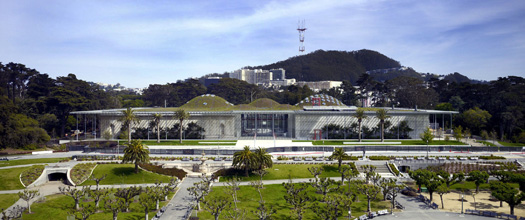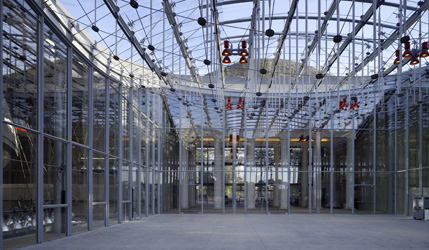The new home of the California Academy of Sciences, which reopened in San Francisco’s Golden Gate Park on September 27, recently received the U.S Green Building Council’s (USGBC) highest mark, Platinum-level certification for Leadership in Energy and Environmental Design (LEED). This distinction makes it both the greenest museum in the world and the largest Platinum-rated public building in the world.

San Francisco’s newly reopened California Academy of Sciences is the greenest museum in the world. Photo by Tom Griffith
By Bill Picture
Published: November, 2008
According to the museum’s executive director, Dr. Gregory Farrington, it was the institution’s visionary Board of Trustees that pushed for as many green elements as possible to be included in the building’s overall design. But the new building—which houses the Steinhart Aquarium, the Morrison Planetarium and the Kimball Natural History Museum—exceeded expectations, including those of the USGBC. Our goal was to create a new facility that would not only hold powerful exhibits, but also serve as one itself, inspiring visitors to conserve natural resources and help sustain the diversity of life on Earth, Farrington explained.
The agency’s rating system, which allocates points in six different sustainability categories—sustainable site, water efficiency, energy and atmosphere, materials and resources, indoor environmental quality, and innovation and design process—requires that a building earn a minimum of 52 points to be certified Platinum. The new Academy of Sciences earned 54 points and, in the process, set a new standard for sustainable architecture in civic buildings.
One of the things to remember is that there are no magic silver bullets for sustainable design, said Aaron Pope, Manager of Sustainability Programs for the Academy. What makes a building green is a series of features that, when you add them up, little by little, eat away at resource use through good planning and smart design.
Green from the Top Down
The new facility brings the original Academy’s eight buildings under a single roof. And that roof is one of the building’s most unique and innovative green features. Award-winning Italian architect Renzo Piano, who designed the building with local firm Stantec Architecture (formerly Chong Partners), came up with the novel idea of lifting up a section of Golden Gate Park and putting a museum under it.
From the air, one might have a hard time locating the museum, as the entire structure is topped with a 2.5-acre living roof that helps it blend into the surrounding park. Covered with 1.7 million California plants, the roof is the largest concentration of California-native species in San Francisco, and provides a unique habitat for a variety of birds and insects.
Because all nine species of plants, which are planted in biodegradable coconut husk trays, are native to drought-prone California, they do not require artificial irrigation. The roof will absorb enough rainwater to sustain the living roof, and prevent millions of gallons of runoff from carrying pollutants into the ecosystem.
Let There Be Light
Windows have been installed in 90 percent of the museum’s regularly-occupied spaces, and skylights were strategically placed on the roof to allow in natural light. A solar canopy containing 60,000 photovoltaic cells trims the perimeter of the roof, and is expected to generate enough clean energy to meet 10 percent of the Academy’s electricity needs. Water-efficient, sensor-triggered faucets in the bathrooms run off their own rechargeable energy source. Running water turns a small turbine inside each faucet that recharges its battery for the next user.
These features, along with photosensors that measure daylight penetration and adjust electric lights throughout the museum accordingly, will allow the new Academy to use 35 percent less electricity than its predecessor and prevent the release of 405,000 pounds of greenhouse gases annually. That’s the equivalent of planting 340 trees each year.
Keeping It Just Right
Keeping a building of this size from getting too cold or too hot isn’t easy, but its designers are confident that this can be achieved by using old-school technology in new ways. The skylights in the roof will open automatically to vent hot air. And an open piazza at the building’s heart draws in cool air, naturally ventilating the surrounding exhibit spaces. Operable windows allow for more ventilation in staff areas, and the living roof acts as insulation, reducing the need for air-conditioning. On chilly days, energy-efficient radiant floor heating will be used to keep public spaces and offices at a consistent and comfortable temperature.
Waste Not, Want Not
It’s no secret that drinkable water is a commodity in California, so the Academy intends to reduce its use by 30 percent. That will be accomplished by using reclaimed water from the City of San Francisco to flush low-flow toilets in bathrooms. Furthermore, saltwater for aquarium exhibits comes directly from the Pacific Ocean. It’s brought in using an underground system of pipes that leads from the ocean to the museum, further minimizing the use of potable water. Natural systems will be used to filter waste from aquarium water, so that the water can be recycled.
The new Academy of Sciences also scored major points for the use of recycled materials for construction. All of the structural steel and rebar used was recycled, and the cement was mixed with 50 percent industrial by-products. Of the wood used, half was certified as sustainably harvested by the Forest Stewardship Council.
Instead of fiberglass insulation, the new Academy’s walls are insulated with recycled blue jeans. The cotton from blue jeans actually holds more heat and absorbs sound better than fiberglass. Furthermore, 20 percent of all the building materials were procured from sources within 500 miles to reduce transportation-related fuel-use and support the regional economy.
The Tip of the Green Iceberg
The new Academy’s green shell isn’t the only proof of its Board of Trustees’ commitment to conservation and preservation. These themes also figure largely into the content of each of the exhibits on display.
In Altered State, for instance, a series of modules demonstrates the local impact of climate change. From the carbon-drenched Pacific Ocean and fast-disappearing tidal wetlands, to shrinking snowfields in the Sierra Nevadas and moisture-starved redwood forests, the effect of fast-rising temperatures on each of California’s delicate ecosystems (and their inhabitants) is examined.
Fragile Planet, the inaugural show at the new, state-of the-art Morrison Planetarium, further echoes this message of sustainability, using the unavailability of life-sustaining resources on other planets to show how important it is to protect the Earth’s precious natural resources.
While the palpable sense of urgency contained in its message may be new, Academy Dean of Science and Research, David P. Mindell, insists that the Academy’s goal is the same—to provide the information necessary to inspire action. The more we understand about the natural world, the more power we have to promote the health of the planet and human well-being, he explains.
Need a Lift?
It’s difficult to accurately calculate how many pounds of carbon are released into the atmosphere each year by museum-bound vehicles. In the Academy’s view, however, any amount is too much. So the Academy is doing what it can to promote eco-sensitive travel to and from its facility. In addition to plenty of secure bicycle parking, the new Academy also features an electric car recharging station.
To encourage visitors to use public transit, the City of San Francisco and the San Francisco Municipal Transportation Agency recently added a new Muni line, the 74X Culture Bus, that links the Academy of Sciences and its neighbor, the de Young Museum, with museums downtown. The biodiesel and diesel hybrid buses are a convenient, economical and eco-friendly way to see all of San Francisco’s world-class cultural institutions.
Through sustainable architecture and innovative design we are adding a vital new element to Golden Gate Park and expressing the Academy’s dedication to environmental responsibility, says architect Renzo Piano. [It is] an invaluable gift, adds Senior Aquatic Biologist, John McCosker, an architectural gem and unparalleled education resource that will inspire millions of visitors to seek sustainable solutions in their own lives.
For more information on the California Academy of Sciences, visit www.calacademy.org

The 410,00-square-foot building features a 2.5-acre living roof that insulates the building and provides a unique habitat for many species of birds and insects. Photo by Tom Griffith

The building’s central piazza draws in cool air and provides natural ventilation for surrounding exhibit space. Photo by Tim Griffith

